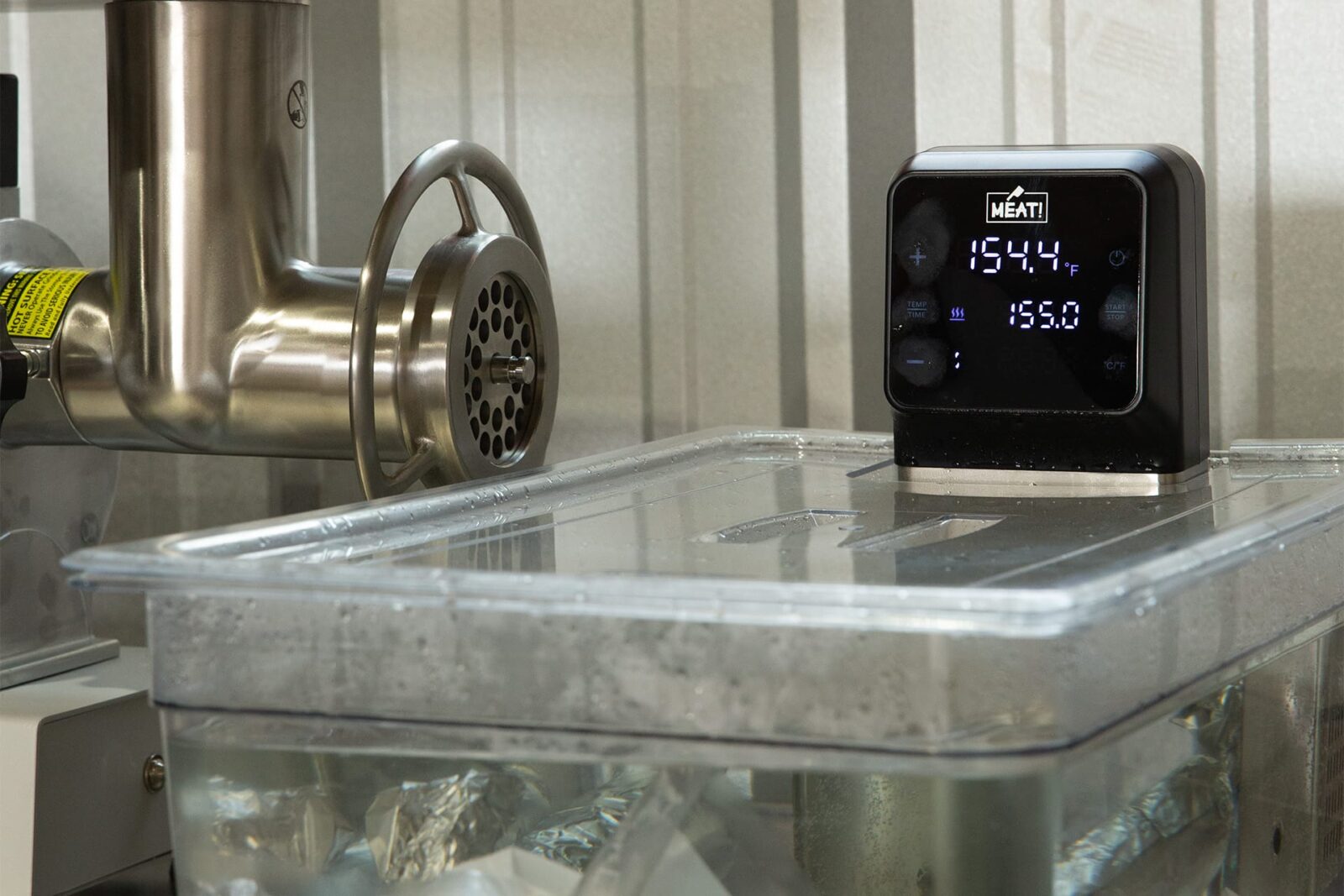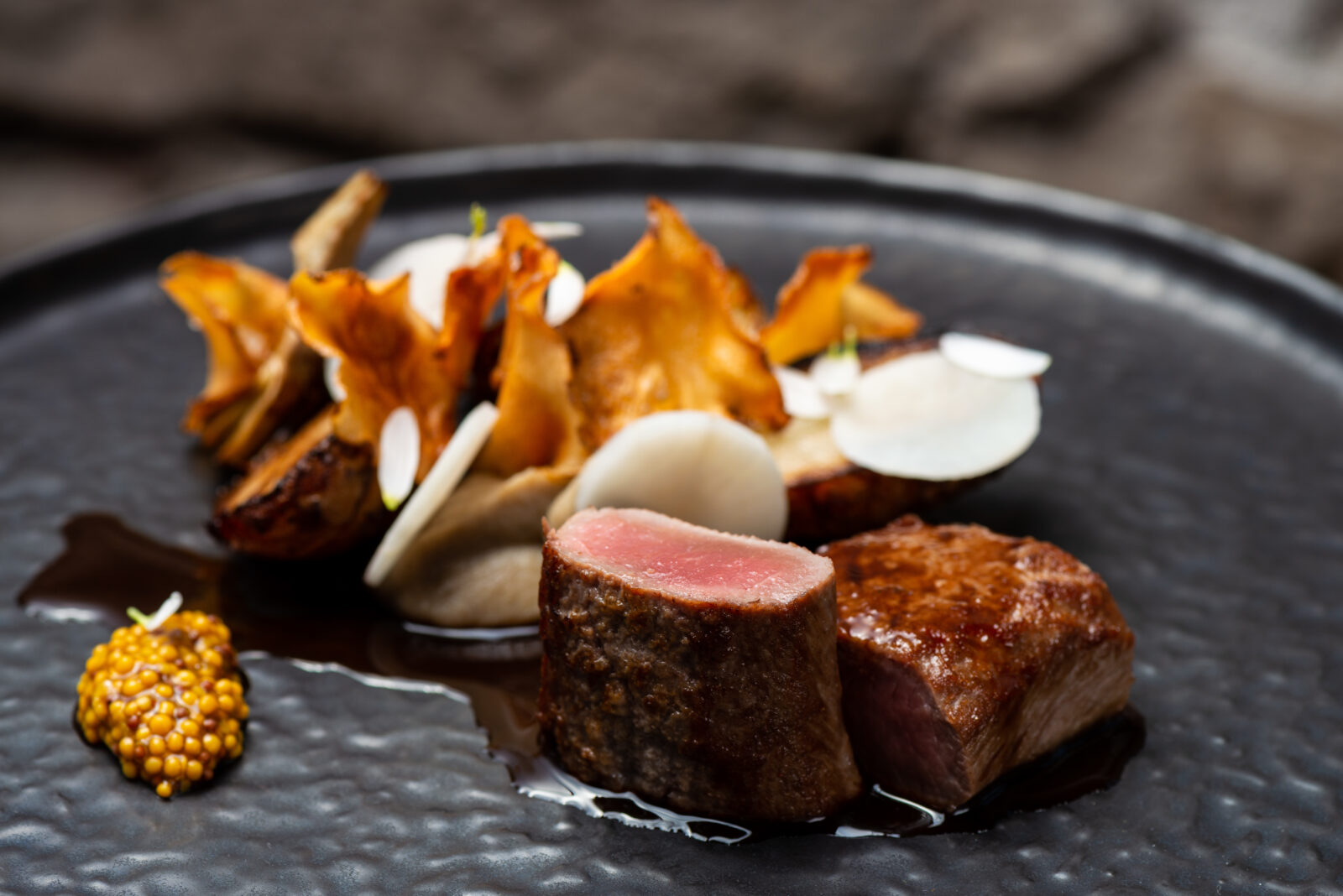Wilderness to Table chef Bri Van Scotter shares why the sous vide cooking method is a preferred way to prepare wild game. She shares tips and a recipe for her Chile-Coffee Spiced Venison Loin with onX Hunt.
In five short years, sous vide (pronounced sue veed) immersion circulators have brought water bath cooking out of the fringe and placed it next to the home kitchen fridge. Though used in professional restaurants for decades, sous vide cooking is approachable for every hobbyist chef and hunter because it comes with one crucial guarantee: you can’t overcook meat with it.
What Is Sous Vide Cooking?
“Sous vide, in French, means ‘under vacuum,’” says Wilderness to Table host and chef Bri Van Scotter. “Being under vacuum is an essential part of the sous vide process because you take a plastic bag, put meat inside, and you vacuum seal it so all the air is out. That puts the meat under pressure a little bit, and then you put it in a controlled water bath. Sous vide is a very controlled, precise cooking method.”
The artistry of sous vide cooking is that your meat or main course is never exposed to temperatures any higher than what you want it to finish at. Want a medium-rare steak with an internal temperature of 130°F? Set your water bath to 130°F and drop in the vacuum-sealed steak. From edge to edge, that entree will come out a perfect mid-rare.
The “hack” of using sous vide is that it allows you to cook meats, even chicken, to temps below 165°F. If you’ve ever been in a ServSafe class or worked in fast food you learned that to eliminate the risk of bacteria in food you should cook it to 165°F because at that temperature it’s instantly pasteurized. You also learned that any food between 40-140°F is in the “danger zone,” and not the one in which Tom Cruise thrives.
Pasteurization can occur below 165°F if given enough time. A burger coming out of a fast food joint doesn’t have time, but a home cook does. The USDA touts the 165°F flashpoint for meat so there is a 7.0 log10 relative reduction in salmonella bacteria, which means a reduction that guarantees that out of every 10,000,000 bacteria living on that piece of raw meat to start only one will survive. However, bringing a piece of chicken with 5% fat content to 145°F for 9.2 minutes will achieve the same level of pasteurization. Want that chicken at 150°F instead? Hold it in the water bath long enough that the meat’s internal temperature stays 150°F for 2.8 minutes and it’s safe to eat.

The History of Sous Vide Cooking
Immersion circulators were invented as equipment for scientific laboratories. Almost anywhere you would use a Bunsen burner you could use instead a temperature-controlled water bath, which was perfect for incubating live cell cultures.
It was during the 1960s that vacuum-packing and food-grade plastic films were more mainstream at large commercial food companies, so the sous vide technique was used only as a safety measure to pasteurize industrially prepared foods to increase their shelf life.
In the mid-1970s French chef Pierre Troisgros brought the sous vide into his kitchen. It is said he wanted to develop a new way to cook foie gras, which by French law is the liver of a duck or goose that has been fattened by force-feeding. The fatty flavor of foie gras could be lost too easily with direct-heat cooking techniques. A chef Troisgro hired found that the delicacy lost the least amount of fat when poached at a precise temperature while sealed in plastic.
In the early 2000s, thanks to the Internet, the sous vide technique began making its way into the kitchens of U.S. restaurants. Chef Thomas Keller was purportedly the first to use sous vide with success in his award-winning restaurants. Before the end of that decade, the sous vide had been the subject of at least one cookbook, a New York Times article (calling it “cryovacking”), and used by acclaimed New York chef Wylie Dufresne to battle against Mario Batali in season two of Iron Chef, cooking delicate, flaky tilapia.
Still, sous vide circulators were expensive, running over $1,000 for a professional device. In 2009 the first sous vide was made available for under $500, but not until 2016 would they drop under $200. Today, MEAT! offers two circulators under $200, along with vacuum sealers.
“I started cooking sous vide way back in the day,” says Van Scotter. “I was working in fine dining at Charlie Palmer Steak and we thought we were innovators. Now I use them for everything, and they’re so small, too. When I was using them in the restaurant they were these big things. Now it’s small and so easy to use.”
Cooking With Sous Vide
While the sous vide water circulator might not replace every cooking tool, pot, or pan in the kitchen, it does play very nicely alongside them. One of the best companions for sous vide cooking is a trustworthy cast iron pan.
“If you’re going to take a cut of meat,” says Van Scotter, “like venison, or beef, or pork, I like to sear it first on a hot cast iron skillet to create Maillard reactions, which is the caramelization of sugars in the meat. That’s going to impart really good flavor once it’s vacuum sealed and put in the sous vide for a long period of time.
“Sous vide is a wonderful cooking method for any tough meat, but it’s also a delicate enough technique to handle any delicate meats, such as flaky fish. It’s probably the most universal cooking tool you could have in your kitchen. Now I use it for sauces, jams, and in almost all parts of the kitchen.
“Once you do it one time and get the feel for it it’s really just about setting the temperature and letting it go. What I love for wild game with sous vide is that I always tell people to cook their game low and slow when they ask for tips because wild game doesn’t usually have all the intramuscular fat that farm-raised beef or pork do. With sous vide you could put butter or olive oil in the bag and cook it slowly, letting those fats absorb into the meat.
“When you cook wild game on the grill at a high temp, for instance, that meat typically doesn’t have enough fat to keep the meat moist and tender on the inside. Whereas the sous vide method keeps everything on the inside. Then you get the exact desired result instead of guessing on a grill.”

- 2 tablespoons ground dark roast coffee
- 2 tablespoons ancho chili powder
- 1 tablespoon brown sugar
- 1 tablespoon smoked paprika
- 1 tablespoon kosher salt
- 1 teaspoon ground cumin
- 7 garlic cloves
- 2 sprigs of thyme
- 1 sprig of rosemary
- 1/4 cup tablespoon extra virgin olive oil
- Set your sous vide machine for 129F.
- In a small mixing bowl combine the ground coffee, chili powder, brown sugar, smoked paprika, salt, and cumin. Mix the spices together to combine well.
- Season the venison loin liberally with the spice mixture.
- In a vacuum seal bag, add the seasoned venison loin to the bag, along with the garlic cloves, thyme, rosemary, and extra virgin olive oil. Vacuum seal the bag. Then place the bag in the water to cook for 1 hour.
- After the loin has cooked for an hour, place a cast iron skillet over high heat. Remove the loin from the bag, and set it aside. Add the oil, garlic, and herbs from the bag to the pan. When the pan is hot add the venison loin to the pan. Sear on all sides of the loin.
- Once, all sides are seared, place the loin on a clean cutting board and slice in 1-2 inch thick pieces.